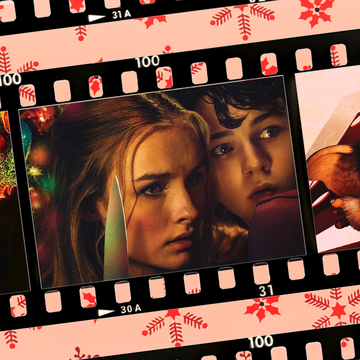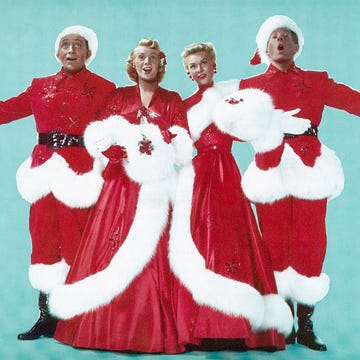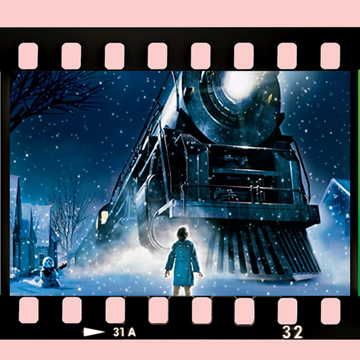1Wreaths
 Marc Mcdermott / EyeEm//Getty Images
Marc Mcdermott / EyeEm//Getty ImagesIn Northern Europe, the pagans believed the sun was a wheel that rolled away from the Earth during the winter, and decorated their homes with wheels festooned with greenery and lights to coax the sun back toward them during winter solstice. As they began to convert to Christianity, the wreaths took on new symbolism. The evergreens and unbroken circle reminded them of God's eternal love and the salvation that Jesus brought to the world.
RELATED: 25 Interesting Christmas Facts You Probably Didn't Know Before This Moment
2Candy Canes
 Annette Bunch//Getty Images
Annette Bunch//Getty ImagesCandy canes allegedly first came about to keep kids quiet, so if you still use them that way, you've got history on your side. In 1670, a choirmaster at the Cathedral of Cologne couldn't keep the choir members from talking during rehearsal for an upcoming live Nativity Scene presentation, so he wanted to hand out peppermint sticks (a popular treat at the time) to keep them busy. He asked a local candy-maker to bend them into the shape of a shepherd's hook, to remind the children that Jesus is the "good shepherd" who keeps his flock safe. The crook-shaped candies spread across Europe, and are still in use today.
Advertisement - Continue Reading Below
3Christmas Tree
 Village Production//Getty Images
Village Production//Getty ImagesWhile many different cultures have used evergreens to decorate during the long, cold winter, 16th-century Germany likely popularized the light-draped Christmas tree as we know it today. As the story goes, Martin Luther went walking in the woods one night and was struck by the beauty of the stars filtering through the evergreens. He cut one down, brought it home, and decorated it with candles to recreate the scene for his family. The idea spread, and now Christmas just wouldn't be the same without a tree.
4Star Tree-Toppers
 Alexandra Ribeiro / EyeEm//Getty Images
Alexandra Ribeiro / EyeEm//Getty ImagesMany people top their Christmas trees with a shining star, and others incorporate the design into their decorations in other ways. The star may be one of the most directly biblical Christmas symbols that has made its way into even secular celebrations. It represents the star that appeared in the sky after Jesus was born, which then led the Three Wise Men to visit him in Bethlehem. It also reminds Christians to follow Jesus like their own guiding light.
RELATED: Unique Christmas Tree Toppers to Match Any Holiday Theme
Advertisement - Continue Reading Below
5Holly
 sbk_20d pictures//Getty Images
sbk_20d pictures//Getty ImagesWith its prickly leaves and red berries, the thorny plant reminds Christians of the crown of thorns that Jesus wore when he was crucified and the blood he shed during that event. That may seem like a macabre reminder during a happy celebration, but the symbol has persisted throughout the ages. In fact, the word for holly in some Scandinavian languages even translates as "Christ-thorn."
6Pointsettias
 Pannonia//Getty Images
Pannonia//Getty ImagesYou may think their bright red color against their green leaves is the only reason we associate the poinsettia flower with Christmas, but it actually has its roots in Mexican folklore. As the story goes, two children named Maria and Pablo wanted to bring gifts to their town's Nativity scene but didn't have the money. So, they picked up some pretty leaves on the road. The townsfolk teased them about their offering, but as Maria and Pablo placed their gifts around the manger, the magically bloomed into the star-shaped flowers.
Advertisement - Continue Reading Below
7Christmas Stockings
 Sarah Bossert//Getty Images
Sarah Bossert//Getty ImagesPeople have been hanging their stockings by the chimney with care since at least the 1800s, and no one knows for sure how it started. The most popular story says that an old man was worried about his three daughters' future, as he didn't have enough money to give them good wedding dowries. Saint Nicholas apparently heard of their plight and wanted to help but knew the man wouldn't accept charity. Instead, he slipped down their chimney and deposited gold into each of the girls' stockings, which were hung by the fireplace to dry.
RELATED: 20 Personalized Stockings for Every Member of the Family
8Decorating With Lights
 Sandra Stoiber / EyeEm//Getty Images
Sandra Stoiber / EyeEm//Getty ImagesChristmas comes at a cold, dark time in much of the world, so decorating with lights that brighten things up makes sense even if you don't think about what they mean. For Christians, the lights symbolize Jesus' status as the Light of the World, and the way he came to save people from darkness.
Advertisement - Continue Reading Below
9Christmas Gifts
 EllenMoran//Getty Images
EllenMoran//Getty ImagesYour kids may ask, "If Christmas is Jesus' birthday, why do we get presents?" While that pile of gifts by the tree may seem totally secular, remember it finds its origins in one of the traditional Bible stories. The Three Wise Men arrived with gifts for the baby Jesus: gold, frankincense, and myrrh. While we don't exchange quite the same presents in modern times, the spirit remains the same.
RELATED: The Best Christmas Gift Ideas for 2022
10Mistletoe
 marilyna//Getty Images
marilyna//Getty ImagesThe custom of kissing under the mistletoe dates back to at least the 1800s, since Washington Irving mentioned it in one of his stories in 1820. It's represented fertility, romance, and vitality since ancient times, so no wonder we pucker up beneath it. But there's another element of the aphrodisiac you may want to know. Mistletoe's seeds can be spread through birds’ feces, so the name comes from the German mist, which means “dung,” and tang, which means “branch.”
Advertisement - Continue Reading Below
11Tinsel
 Kristina Jackson//Getty Images
Kristina Jackson//Getty ImagesDecorating with tinsel comes from an Ukrainian tale in which a poor household found a pinecone rooted outside and brought it in for a Christmas tree. The family was too poor to decorate it, so they went to bed with a bare tree. But overnight, a spider crept in and spun beautiful webs all over it. As the sun rose, it turned the threads silver and gold, making it a merry Christmas for them after all. Today, many Eastern European households hang a spider on their tree to commemorate the legend, and the rest of us hang tinsel and garlands.

Lizz (she/her) is a senior editor at Good Housekeeping, where she runs the GH Book Club, edits essays and long-form features and writes about pets, books and lifestyle topics. A journalist for almost two decades, she is the author of Biography of a Body and Buffalo Steel. She also teaches journalism as an adjunct professor at New York University's School of Professional Studies and creative nonfiction at the Muse Writing Center, and coaches with the New York Writing Room.
Advertisement - Continue Reading Below
Advertisement - Continue Reading Below
Advertisement - Continue Reading Below

























